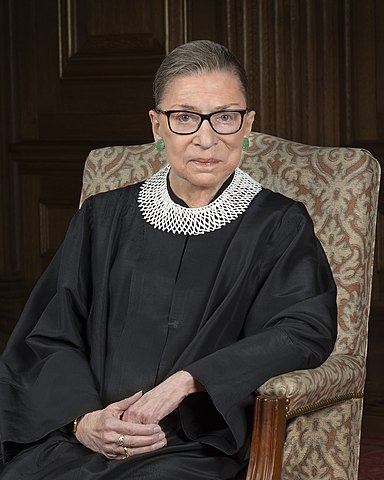Ruth Bader Ginsburg: Her Life and Legacy

Ruth Bader Ginsburg Photo; Creative Commons
October 18, 2021
A woman who inspired many, broke barriers, and dazzled DC with her intelligence, Ruth Bader Ginsburg, also known as RBG, was a woman of immense brilliance and passion. RBG served on the Supreme Court from 1993 until her death in September of 2020. How did RBG change the judicial system, and how did she alter the women’s rights movement? RBG left behind a legacy that will never be forgotten, and words that will always be recited.
Ruth Bader Ginsburg (RBG) was born in Brooklyn on March 15th, 1933. Ginsburg attended James Madison High School in New York and excelled greatly in her academics. According to History.com, RBG graduated from Cornell University in 1954. After getting married, Ginsburg enrolled at Harvard University where she was one of eight women in her class of 500. Afterward, she taught at Rutgers University Law School and Columbia University, where she became the first female tenured professor.
Ginsburg became extremely involved in the women’s liberation movement early in her law career. According to Britannica.com, in 1971 she published two law review articles on the subject of gender discrimination. In 1972 she became founding counsel of The ACLU’s Women’s Rights Project. According to Insider, the equal access to education for women case (United States v. Virginia, 1996), was a major turning point for women everywhere, as well as Ginsburg’s role as a leader in women’s liberation.
Ginsburg continued to show the world that gender does not discriminate, and a woman can be just as brilliant as a man. “Ginsburg left a legacy of intelligence and strong-willed women,” said Francesca Mangot, a lawyer clerking for a NJ Supreme Court Justice. “She changed how the world viewed women’s rights, as well as gave numerous girls around the world a role model that you can be whatever you want to be in this lifetime. She broke women’s rights barriers and helped expand the education of the supreme court. RBG was absolutely a major factor in the women’s rights movements of the ’60s and ’70s because of her creativity in choosing what cases she argued before SCOTUS. Justice Ginsburg’s strategy was to challenge laws that actually FAVORED women. She argued the laws favored women for impermissible reasons based on gender stereotypes (namely that women are caretakers and men are breadwinners). Therefore, by representing MEN, she was actually able to establish precedent that laws cannot be based on impermissible gender biases.” RBGs legacy will never be forgotten, and her creativity and brilliance will always be remembered.
Ginsburg broke barriers and worked hard to destroy the patriarchy. According to Britannica.com, on June 14, 1993, President Bill Clinton announced his nomination of Ginsburg to the Supreme Court, replacing Justice Byron White. She won over the Senate by a vote of 96-3. Ginsburg changed the gender stereotypes in everyday life as well. “In Weinberger v. Wiesenfeld, RBG represented a man whose wife died in childbirth,” Mangot said. “The wife had been the main income earner for the family, so when she passed away, the husband applied for Social Security benefits. He was denied any benefits because the law only provided that WOMEN and dependent children were eligible to receive them. RBG once again argued that the law was impermissible discrimination based on sex.”
After an incredible career thus far, Ginsburg was diagnosed with cancer. According to UC Press, in 1999 Ginsburg had her first fight with colorectal cancer. In 2009, she was diagnosed with pancreatic cancer and began her second fight with the grueling disease. On September 18th, 2020, after a long fight, Ruth Bader Ginsburg, at the age of 87, died of her cancer.
Ginsberg implemented change to the world, as well as inspiring so many young women. She changed how the world viewed women’s rights, as well as gave numerous girls around the world a role model, showing them that they can be whatever they want to be in this lifetime. She broke women’s rights barriers and helped expand the education of the supreme court.

















































































































































